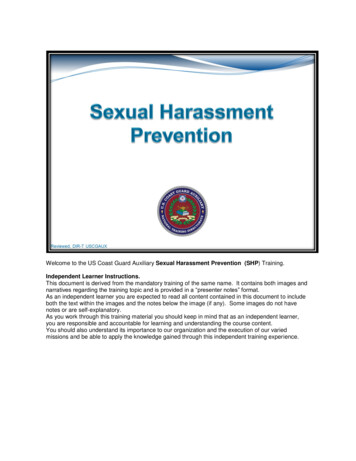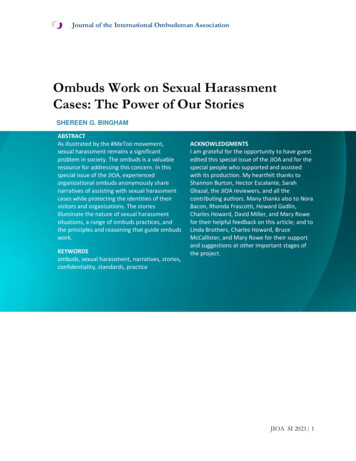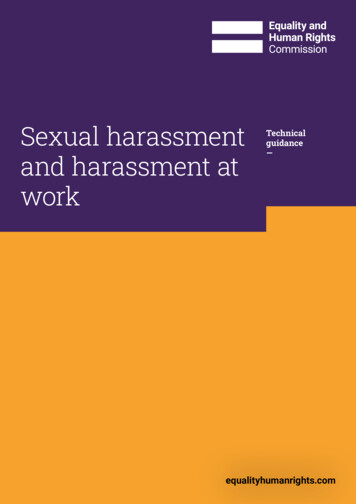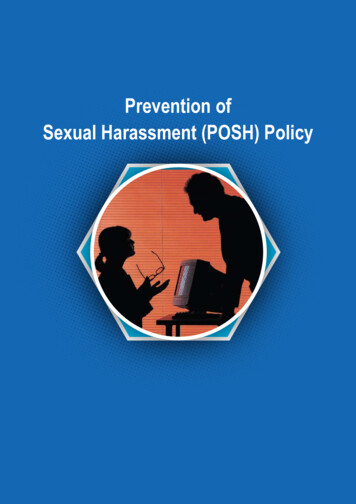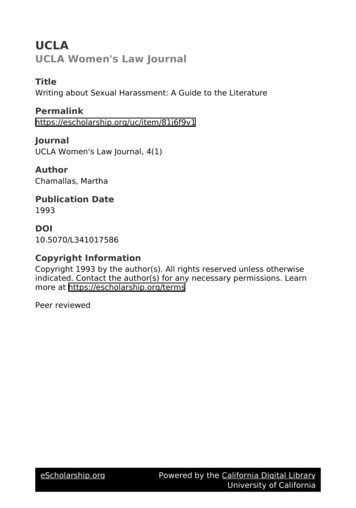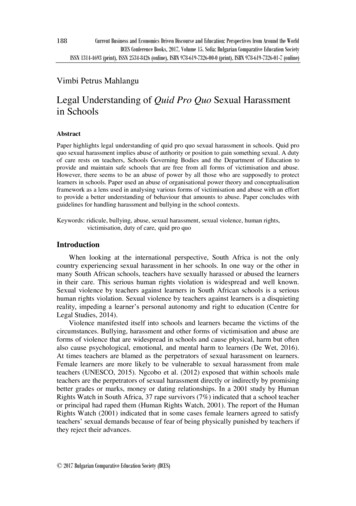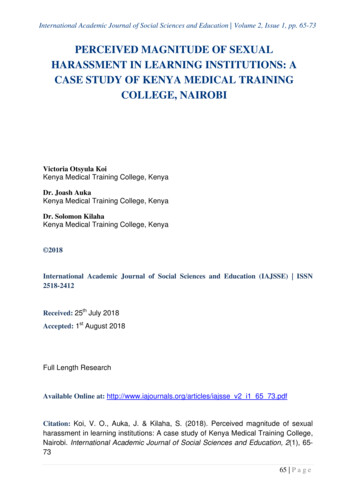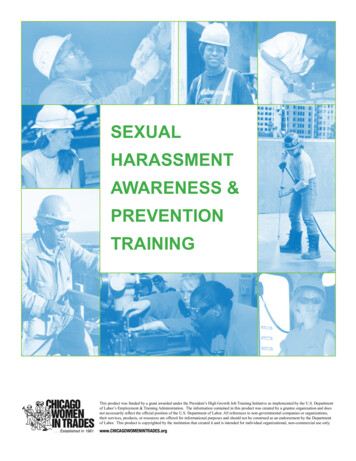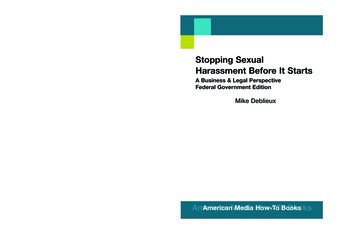
Transcription
94208 HARAE Cover BlackQuick Chapter ReferenceStopping SexualHarassment Before It StartsWhen an employee files a sexual harassment complaint,your organization could lose more than just a court case.Avoid lost time, lost productivity, lost profits—and the lossof your company’s good reputation—by stopping sexualharassment before it starts.Mike Deblieux is a nationally recognized human resourcesmanagement consultant and president of Mike DeblieuxHuman Resources in Tustin, California.A Business & Legal PerspectiveFederal Government EditionMike DeblieuxEach book in the American Media How-To Series presentsvaluable information in a self-study format. Whether it’sinterviewing, customer service, or even termination skills,American Media’s How-To Series of books will help youdevelop and retain a competitive advantage in today’sworkplace.AmericanMediaMedia How-ToBooksAmericanHow-ToBooks
Stopping SexualHarassment BeforeIt Starts:A Business and LegalPerspectiveFederal Government EditionMike DeblieuxAmerican Media Publishing4621 121ST StreetUrbandale IA, 50323-23111-888-776-8268www.ammedia.com
Stopping Sexual Harassment Before It Starts:A Business and Legal PerspectiveFederal Government EditionMike DeblieuxCopyright 1997, 1998, 2003 by American Media PublishingAll rights reserved. No part of this publication may be reproduced, stored in a retrievalsystem, or transmitted in any form or by any means—electronic, mechanical, photocopying,recording, or otherwise—without the prior written permission of the publisher.This publication is designed to provide accurate and authoritative information on the subjectmatter covered. It is sold with the understanding that neither the author nor the publisher isengaged in rendering legal, accounting, or other professional services. If legal advice or otherexpert assistance is required, the services of a competent professional should be sought.Credits:American Media PublishingEditor in ChiefDesignerCover Design and IllustrationArthur BauerTodd McDonaldKaren Massetti MillerGayle O’BrienKevin ZdenekPublished by American Media Publishing4621 121ST StreetUrbandale IA, 50323-2311Second EditionLibrary of Congress Catalog Card Number 97-070154Deblieux, MikeStopping Sexual Harassment Before It Starts: A Business and Legal PerspectiveISBN 1-884926-75-4Printed in the United States of America01 00 99 989 8 7 6 5 4 3 2 1
IntroductionSexual harassment is one of the most complex workplace issues of our time. It is atonce a legal issue, an emotional issue, a civil rights issue, and a very personal issue.It can be both easy to define and impossible to define. It can result from innocentactions or from criminal behavior. It can take place in a few seconds or require severalyears to develop. It can be a very public matter or an extremely private issue.But one thing is clear about sexual harassment. It must be taken seriously by allemployers. Large and small organizations across the United States are being heldaccountable for incidents of sexual harassment. Every employer has the duty—and theresponsibility—to provide a harassment-free work environment by establishing clearpolicies against sexual harassment and by training executives, managers, supervisors,and employees to prevent, recognize, and report all incidents of sexual harassment.Just as important, managers also must take steps to ensure that vendors, visitors, andcustomers comply with their company’s sexual harassment policies.This book was written to help you understand why preventing sexual harassment issuch an important work issue. It includes examples to illustrate both inappropriateand appropriate behavior as well as exercises to help you better understand how youand your organization can prevent sexual harassment. It shows what you can do tomake sure the people you work with can come to work and do the job they were hiredto do in an environment free of all forms of harassment.Thank you for buying this book. More importantly, thank you for investing yourtime to learn more about this important topic.About This BookWe have written and designed this book to make it easy for you to apply theinformation you learn to your particular job. Each chapter begins with Chapter Objectives that explain what you will learnwhen you read and study that chapter. What Do You Think? vignettes at the beginning of each chapter serve as shortstories about workplace incidents to help you visualize how they can cause orprevent sexual harassment. For Your Information boxes are included throughout the book to expand onselected topics with key information or additional resources. Take a Moment exercises provide brief exercises or assignments to help youlearn even more about sexual harassment. Self-Check reviews at the end of each chapter let you test your understanding ofthe information and reinforce what you’ve learned.
What You Will Gain from Reading This BookRegardless of your role in the workplace, you have the potential to be a leader. Thisbook will help you improve your leadership skills. It will help you plan your workdayand your interactions with coworkers to ensure that you treat them with respect anddignity. At the same time, it will help you set an example for the people around youand avoid costly grievances and lawsuits that may result from inappropriateworkplace behavior.As a result of reading, studying, and reflecting on the information in this book, youshould be able to: Explain why sexual harassment is both a legal issue and a productivity issue in theworkplace. Explain why sexual harassment is a discrimination issue. Take steps to prevent intentional and unintentional sexual harassment. Avoid behavior that might be interpreted as a misuse of your authority as asupervisor to gain sexual favors from employees. Establish behavioral expectations for employees, visitors, and customers that willensure that your workplace is free of all forms of harassment. Implement effective policies and procedures to prevent, recognize, and report allincidents of sexual harassment. Cooperate with human resources, legal, and management staffs to investigate andresolve all reported incidents of sexual harassment.AcknowledgmentsThe author wishes to thank Art Bauer, Todd McDonald, and Karen Massetti Miller atAmerican Media for their help, support, and assistance in writing this book. Thanksand appreciation also are extended to Lee Paterson, attorney at law, and to Teri Tracy,attorney at law, for their roles as mentors and friends. Special thanks also go to KarenNichols for a never-failing helpful hand in juggling my calendar, travel arrangements,workshop materials, and business commitments.This book is dedicated to my very special daughters, Nicole and Danielle,in the hope that the workplace they enter will be free of the discrimination,harassment, and sexual harassment that permeated my first workplace in1971. It also is dedicated to the thousands of people who have attended myworkshops, asked me questions, and shared stories that have raised my ownconsciousness on this important issue.
About the AuthorMike Deblieux, a nationally recognized human resources management trainer andconsultant, is president of Mike Deblieux Human Resources in Tustin, California.He designs and presents training programs on human resources-related issues such asdocumenting discipline, writing performance reviews, interviewing, preventing sexualharassment, equal employment opportunity, affirmative action, and workplaceviolence. Mike presents more than 100 such programs each year to organizations ofall sizes.Mike also is an instructor for the University of California, Irvine, Extension HumanResources Management Certificate Program, and has received the Extension’s covetedDistinguished Instructor Award. He serves as Course Leader and Blue RibbonSpeaker for the American Management Association (AMA), as well as course leaderfor The Employers Group and the Professionals in Human Resources Association(PIHRA).Mike also has written Documenting Discipline and Legal Issues for Managers: EssentialSkills for Avoiding Your Day in Court for American Media Publishing. American Mediahas produced two training videos, How to Legally Document Employee Discipline andLegal Issues for Managers, based on his books. The books and videos may be ordered bycalling 1-888-776-8268. Mike can be reached by phone at 714-669-0309 or by e-mailat mike@deblieux.com. You may visit his website at www.deblieux.com.A Note on Gender and Ethnic ReferencesThe workplace in the United States has become increasingly diverse. Men and womenrepresenting a wide a variety of life experiences enter this workplace every day. Inwriting this book, I’ve tried to reflect this great diversity in a number of ways. Thebook includes examples that reflect the many different roles women and men play intoday’s workplace. In some examples, a man is cast as a manager; in others, a womanhas that role. In still other examples, the text is gender neutral to reflect the fact thatboth men and women can be victims of sexual harassment.In some instances, the text uses the phrase “he or she”; in others, it uses “she or he.”Likewise, Native American, Hispanic American, Asian American, and AfricanAmerican workers appear in a variety of roles in the illustrative examples to reflecttheir important roles in the workplace.It’s my hope that this approach will increase your appreciation of the rich diversity ofour collective workplace, as well as the increasingly complex nature of sexualharassment.
Table of ContentsChapter OneWhy Is Sexual Harassment an Issue?8What Do You Think?Why Is Sexual Harassment a Workplace Issue?Sexual Harassment and the LawSexual Harassment and the Diversity of the WorkplaceSexual Harassment and Initiation Rites and Past PracticesSexual Harassment and FamiliaritySexual Harassment and Female and Male PerspectivesAbuse of Power and Sexual HarassmentChapter SummarySelf-Check: Chapter One Review8101012141617202223Chapter TwoSexual Harassment as DiscriminationWhat Do You Think?Harassment as a Form of DiscriminationTypes of DiscriminationDisparate TreatmentDisparate ImpactRetaliationChapter SummarySelf-Check: Chapter Two Review242425272828303233Chapter ThreeActional Sexual HarassmentWhat Do You Think?Understanding Actional Sexual HarassmentExamples of Actional Sexual HarassmentWho Can Create Actional Sexual Harassment?Supervisory Actions That Prevent Sexual HarassmentPower Is the IssueChapter SummarySelf-Check: Chapter Three Review6343436404243464748
Table of Contents Chapter FourEnvironmental Sexual Harassment50What Do You Think?What Is Unlawful Environmental Sexual Harassment?The Reasonable Person StandardTypes of Environmental Sexual HarassmentEnvironmental Sexual Harassment Based on Verbal HarassmentEnvironmental Sexual Harassment Based on Physical HarassmentEnvironmental Sexual Harassment Based on Visual HarassmentChapter SummarySelf-Check: Chapter Four Review505154545462666970Chapter FivePreventing Sexual Harassment72What Do You Think?Sending a Strong Management MessageConducting the New-Employee OrientationEnsuring Ongoing CommunicationResponding to ExcusesChapter SummarySelf-Check: Chapter Five Review72747476808687Answers to Chapter Reviews887
Why Is Sexual Harassment an Issue?ChapterOneWhy Is Sexual Harassmentan Issue?Chapter Objectives Explain why sexual harassment is a workplace issue. Describe how the Civil Rights Act and sexualharassment relate to each other. Explain how some old, accepted workplace behaviorsare, in fact, sexual harassment. Explain how the use of formal and informal power canboth prevent and create sexual harassment.What Do You Think?t was Friday night. Angelica walked in the door at home. Shehad alternated between tears and anger on the drive from work.Now she just wanted to lock the door to her apartment and shutout the world. But she couldn’t do that. Antonio would be home inless than an hour. They had tickets for a concert by one of theirfavorite musical groups. They had looked forward to this concertfor months. She had to go. She had to have a good time.ICaseStudyIn the bedroom, Angelica slumped onto the bed and began torelive her day for the twentieth time. Her coworkers could be somean sometimes. She worked just as hard as they did. She hadmore education than most of them and traveled more miles peryear than any of them. She had also been Inspector of the Yearfor the past two years.Just before five o’clock, Mr. Camping announced that Angelicahad been chosen Inspector of the Year for the third year in a row.For a moment, she felt so proud. Then she heard Willie say underhis breath, “Body of the year would be more like it.” She had8
Why Is Sexual Harassment an Issue? ignored the remark before, but this time it hurt. Teasing was onething, but this wasn’t teasing. She wasn’t sure she could go backto work Monday morning. She wasn’t even sure she could tellAntonio. She knew she could never tell her parents.1Is Angelica a victim of unlawful workplace sexual harassment?Was the law broken? The answer is maybe. It depends on anumber of things—such as whether incidents like this haveoccurred before and how they affect her role in the workplace.Ultimately, if she files a lawsuit, it will depend on how a courtviews the evidence in her case.Let’s ask a different question about Angelica. Is she a victim ofinappropriate workplace behavior? Here the answer is clearlyyes. Read her story again, and you will see that she has beenvictimized in many different ways. Angelica has beenpsychologically attacked. Willie’s comments have tarnished, ifnot destroyed, her reputation among her coworkers. She hasbeen associated with a tired, old stereotype that says women getahead by sleeping around, not by being good at their jobs. Mostimportantly, her family life has also been affected. Her regularsafety net is not available to her. She cannot comfortably talk toher family about the problem without worrying about how theywill perceive her from that point forward.So is Angelica a victim of sexual harassment? The answer is yes.Is she a victim of unlawful sexual harassment? The answer ismaybe. It depends on what an objective investigation of thefacts reveals about other incidents, the impact on her work, andthe effect on her work environment. In any case, this incident iscause for her employer to be concerned. The employer shouldtake steps to ensure that an incident like this doesn’t occur inthe future: It must adopt and enforce a clear sexual harassment policy. It must train managers, supervisors, and employees tounderstand, recognize, and prevent sexual harassment. It must discipline employees who violate the policy. It must recognize and reward employees at all levels whotreat others with respect and courtesy.Angelicahas beenpsychologicallyattacked.The companyshould takesteps to ensurethat an incidentlike thisdoesn’t occurin the future.9
Why Is Sexual Harassment an Issue?Why Is Sexual Harassment aWorkplace Issue?Sexualharassmentwill not goaway withoutcareful anddeliberateefforts to makeit go away.In the workplace, sexual harassment will not go away withoutcareful and deliberate efforts to make it go away. It is aworkplace issue for several important reasons: The law The diversity of the workplace Initiation rites and past practices Familiarity Female and male perspectives Employee productivityAny one of these issues could make sexual harassment animportant concern, but this unique combination makes it oneof the most important business and social problems of our time.Let’s look at each issue to better understand the impact of sexualharassment on your workplace environment.Sexual Harassment and the Law “Have you heard about the latest human resourcesdepartment seminar?” asked George. “I mean, here we goagain. Another sexual harassment ‘don’t touch, don’t say, don’tbreathe’ lecture by the do-gooders! When are they gonnarealize just how out of touch they are? We’re just trying tohave a little fun around here. They need to get a life.”In 1964, the Civil Rights Act changed the workplace forever. Itplaced a spotlight on how people relate to each other at work. Itopened a national discussion about the roles of minorities andwomen at work. For the first time, it empowered people tospeak out against practices, beliefs, and stereotypes that hadexisted in the workplace for centuries.10
Why Is Sexual Harassment an Issue? Did You Know?The Civil Rights Act of 1964, as amended, prohibitsdiscrimination in the workplace on the basis of sex. Sexualharassment is a form of sex discrimination and is thereforeprohibited by law.1The Civil Rights Act was not passed to stop sexual harassment. Itdoes, however, prohibit discrimination on the basis of sex. Overtime, and as a result of a number of Equal EmploymentOpportunity Commission and court decisions, it has becomeclear that sex discrimination is not limited to hiring andpromotion decisions. Sex discrimination also extends to the waypeople are addressed, thought of, and treated in the workplace.When a person or group is treated differently because of theirsex, they may be a victim of discrimination. If the discriminationhas a sexual connotation—such as sexual jokes, unwelcometouching, or demands that an employee sleep with his or her bossin order to keep a job—it is sex discrimination in the form ofsexual harassment. In addition to the Civil Rights Act, a numberof other federal and state laws prohibit discrimination in theworkplace. In some cases, state laws go beyond the scope offederal law and impose higher standards, wider coverage, andgreater penalties.When a personor group istreateddifferentlybecause oftheir sex, theymay be avictim ofdiscrimination.These laws are widely publicized and have resulted in a firestormof lawsuits. As society has become more aware of bias andprejudice in the workplace, employees increasingly have beenempowered to complain to human resources departments,state agencies, and the courts about discriminatory experiences atwork. As a result, employers understand better than evertheir overwhelming responsibility to create and maintain adiscrimination- and harassment-free workplace. Althoughsubstantial progress has been made, we still have a long way togo. Discrimination, harassment, and sexual harassment continueto exist. Reading this book and implementing the ideas you learnfrom it will help you minimize the possibility of unfair treatmentin your workplace.11
Why Is Sexual Harassment an Issue?Take a MomentCheck the equal employment posters in your workplace. Inaddition to the categories we’ve discussed, list others thatare protected by your state and/or community.Sexual Harassment and the Diversityof the Workplace “I was so embarrassed,” thought Mina. “In my country, a manwould never ask a woman to do those things.”As anincreasingnumber ofwomen andminoritiesjoined theworkforce,they soughtto retain theirown identities.12Diversity has long been a part of the workplace. Historically,it was based primarily on national origin. At the start of thetwentieth century, people from many different Europeancountries were represented in the workforce. Some groups werestronger than others. Some had more power than others. Themajority ruled, and the minority conformed to their wishes.In theory—if not in practice—the idea was that over time,everyone would blend together. In fact, the term melting potwas coined to illustrate how people were expected to shedtheir national origin and adopt the practices and beliefs of themajority.For a long time, the same assumption applied to the workplace.Women and minorities were expected to blend in with the menwho came to the workplace before them. However, as anincreasing number of women and minorities joined theworkforce, they sought to retain their own identities.Women, for example, sought to shed the stereotype that saidthey were best suited for clerical or secretarial work and began topursue jobs in other professions and settings. They began toquestion previously accepted assumptions that allowed womento be addressed as “sweetheart,” “honey,” or “babe” at work.
Why Is Sexual Harassment an Issue? They began to openly question men who propositioned,touched, or pursued them at work when they were simply tryingto do their jobs. As their numbers in the workplace increased andnew laws were enacted to protect them, women were better ableto express their concerns about the ways they were being treated.1Over time, women and minorities found that they did not in facthave to “melt” into the society or workplace that came beforethem. Rather, they sought instead to maintain their ownidentities. In doing so, women learned that they did not have toaccept unwelcome sexual advances, innuendoes, jokes, or stories Diversity hasas a normal part of workplace behavior.changed theIn short, diversity has changed the operating assumptions of theworkplace. When the majority of people in the workplace weremen, their rules determined what was and was not acceptable.But in a diverse workplace, men and women of many colors andcultures establish rules and policies that allow everyone to betreated with respect.operatingassumptions ofthe workplace.Take a MomentWe all contribute to the “diversity salad” of today’sworkplace. Have you thought about your own diversity?What personal and cultural characteristics do you bring tothe workplace? List some of the experiences in your life thatdefine who you are and what is important to you.13
Why Is Sexual Harassment an Issue?Sexual Harassment and Initiation Ritesand Past Practices “I don’t know what she’s complaining about. Hey, it happenedto me when I was new. Why shouldn’t she go through it?” saidGeorge. “My first boss took me to every topless bar in town. Ifshe can’t take it, she shouldn’t be trying to compete in a man’sworld.”Today’sworkforce ismuch lesstradition boundthan in thepast.George seems to think that everyone should have the sameexperiences he had climbing the corporate ladder. Because hesurvived it (or maybe even enjoyed it), he thinks everyone elseshould have to earn their “stripes” in the same way.George is operating under old rules. Today’s workforce is verydifferent and much less tradition-bound than it was when hestarted working. Many of George’s coworkers did not share hisexperiences. In fact, they might be offended that he thinks theyshould have.A very public example of a workplace initiation rite occurred in1996 with a major league baseball team. One of the team’s bestpitchers was a rookie from Korea. During one game, some of histeammates cut the legs off of the pants he planned to wear onthe flight home and left him a shirt and coat that didn’t match.Many of his teammates had been victims of a similar prankwhen they were rookies—they simply thought he should havethe same experience. They expected him to understand that thisinitiation rite meant that he had been accepted by the team.They were shocked when he expressed humiliation andremained distant from them. Apparently in his culture, such aprank was not the way to show respect and camaraderie.Instead, it hurt him personally and publicly embarrassed theteam.14
Why Is Sexual Harassment an Issue? Just like that baseball player, female employees do not alwaysappreciate or respect the traditions of those who came beforethem. A few examples of such past practices include: Getting together for a lunchtime or after-work drink Playing golf Meeting in a hotel room rather than in a meeting room Doing personal errands for the boss to increase your chancesof promotion Using sports analogies in every business discussion1These male-dominated practices of the past are slowly giving wayto a variety of other practices that take into account the interestsand needs of all people in the workplace.Take a MomentThink of some popular Hollywood comedies that haveexplored male-female differences in the workplace—moviessuch as Working Girl, 9 to 5, and Tootsie. What are some ofthe old-school initiation rites and past practices that theysatirized?15
Why Is Sexual Harassment an Issue?Sexual Harassment and Familiarity “Ivorene, we work together every day,” said Tom. “You’resomebody I can talk to easily. I’ve told you about my problemsat home. Last night was the worst. I just kept thinking abouthow much better it would be if I were at your house and wewere just talking and sharing like we do every day.”For Your InformationDepending on who is involved, people can see sexualharassment very differently. In one workshop, a participanttold me that people were just too sensitive at work thesedays, and that all this sexual harassment stuff had ruinedthe workplace.I asked him whether he had any daughters. He told me hehad four daughters. I asked him what he would do if one ofhis daughters came home and told him that a man at workhad groped her, called her “cutie,” and suggested that shespend the night with him.He rose from his seat and said, “I’d go down and kill the!@*!”The old saying “familiarity breeds contempt” applies here.When we work side by side with someone every day, we havea tendency to assume that we can say almost anything to thatperson. Sometimes, because they have shared things with usabout their personal lives, we assume we can be more open withthem than we are with others.Many people—but not all—want to be a friend and help in anyway they can when a coworker is having personal problems. Butfor all of us, there is a line at which we say, “I just don’t want toget that involved in your personal life.”16Many sexual harassment claims result from one person assumingthat a friendly coworker is ready, willing, and able to getinvolved in their personal life. Recently, a human resourcesmanager told me that when she had analyzed sexual harassmentclaims in her company, she was surprised to learn that the oneconstant in every case was that the perpetrator was a man who
Why Is Sexual Harassment an Issue? was experiencing problems at home or who was going througha divorce. In each case, the man shared his problems with a femalecoworker. When the coworker showed concern, the male employeemistook it as an invitation to pursue her on a personal or romanticbasis. When that line was crossed, the female “friend” saw thebehavior as harassment.1Sexual Harassment and Female andMale PerspectivesMore and more literature suggests that men and women sometimessee things differently. We often do the same things in differentways. We even communicate differently. For example, in sexualharassment workshops, I often go through the followingsequence with ticipantsCaseStudyI know this will surprise you, but Ihave observed that womensometimes tell dirty jokes.(Nervous laughter)Who do many women tell their jokes to?(Pause) Other women.Which other women?Their close friends.And where do they often tell these jokes?In private!Who do men tell dirty jokes to?(Loud and unanimous) Everyone.And where do they tell them?(Louder) Anywhere!!!17
Why Is Sexual Harassment an Issue?These differences often go unnoticed until it is too late. We useconvenient excuses like, “Oh, that’s just the way he (or she) is,”to overlook what someone says or does. We use these excuses,that is, until the behavior crosses the invisible line beyond whichwe suddenly consider the behavior inappropriate or intolerable.Then we avoid the person or even complain about him or her tosomeone else. Here are a few examples:The Greeting HugMen sometimes see women hugging when they greet andassume that both of the women like to be hugged. But whena man tries to hug one of the women, he often finds that hisassumption is wrong. Likewise, a woman may assume that a hugshows a man he’s part of her group. He, however, may read thehug as an invitation to pursue her romantically. He may also beoffended.Many womensee terms like“honey” or“sweetheart”as put-downs.The Term of EndearmentSome men use terms like “sweetheart” or “honey” when theytalk to women. These men may see such terms as complimentary,but many women see them as put-downs or condescending.Likewise, when women sometimes use a term like “hunk” todescribe a man, some men hear the term as an invitation topursue a personal relationship with the woman.The Personal ComplimentPersonal compliments can get us into all kinds of trouble atwork. For example, a man might say, “Magaline (pause, breath),you really look nice today.” Magaline may be thoroughlyoffended by this comment. She might interpret it as suggestiveor sexual. The complimenter would probably be surprised. If hehad listened carefully, however, he probably would have foundthat when Magaline’s female friends compliment her, they arevery specific. For example, they might say, “Magaline, that’s alovely dress. Is it new?” To Magaline, there is a world ofdifference between the two compliments. She took the first oneas a comment about her as a person; she took the second as acompliment about her wardrobe.18
Why Is Sexual Harassment an Issue? The difference between how men and women see things isprobably one of the greatest contributors to incidents ofworkplace sexual harassment. One way for us to reduce sexualharassment claims is to increase education and discussion on thedifferences and similarities between how men and women seethings. By sharing and learning, we can anticipate the impact ofour comments and behaviors and prevent them from beingmisinterpreted.1The Productivity Problem “This is a really important project,” thought Lee. “I need toconcentrate on it 110 percent. But how can I concentrate whenshe keeps hitting on me? Besides, her management bonusdepends on this project getting in on time and under budget.How can I get any help when every time I go in there, she tellsme to sit on her desk and puts her hand on my leg? I hate it.Each time it happens, I can’t work for the next 30 minutes.”T
policies against sexual harassment and by training executives, managers, supervisors, and employees to prevent, recognize, and report all incidents of sexual harassment. Just as important, managers also must take steps to ensure that vendors, visitors, and customers comply with their company's sexual harassment policies.

